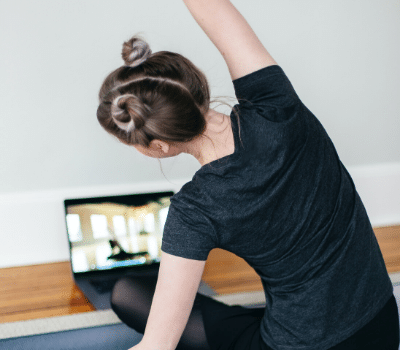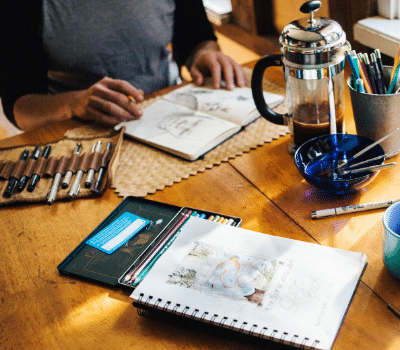

Most of us have good intentions when it comes to a morning routine, but it's not always easy to wake up early and get on with it.
Perhaps you've stayed up too late the night before, maybe you feel groggy when you wake up, or maybe you just don't see the worth of getting up before you absolutely have to.
However, having the right morning routine can set the tone for the day to come, making you feel happier and more productive.
So what should you do if you're struggling to get the best out of your mornings?
Whether you struggle to wake up in the morning or you're already a morning person and just want to get even better at using the early hours of the day, this article can help.
We'll look at the importance of morning routines, how to create one and explore the best habits to practice – including tips for making it easier to get up in the morning.

Simply put, a morning routine is a list of good habits that you do every morning. This can help you get yourself into a good frame of mind for the coming day.
These activities can vary from person to person depending on what your interests and goals are. They might even vary depending on whether it's the working week or the weekend.
With a morning routine, you won't be getting up out of bed with a sense of aimlessness.
This also means you won't be diving out of bed and rushing straight to work, instead, you go straight into a productive routine.
Now, let's look at why this makes a difference, and start thinking about how to create your own routine.

There are a few important reasons why morning routines can improve your well-being.
Perhaps most importantly, you take control of your morning right away, and this will make you feel productive and empowered.
With this mindset established, you're more likely to accomplish more through the rest of the day.
In addition, having a morning routine ensures you make better use of your time – a previously disorganized morning can become a newly streamlined, active period of your day.
Further, if there are things you've been meaning to do and can't find the time to do it, committing to a morning routine helps you make space for those things.
Now, let's think in some more detail about what a good morning routine looks like. Let's look at three tips that will help you begin to design a sustainable, realistic routine that works for you.

Begin by brainstorming a range of ideas about what you could do with your day, and then work through them to choose the ones that sound best.
For example, perhaps you want to sign up for an online class, practice a language, or learn a musical skill.
It's challenging to find time for these things when you have a hectic schedule.
But if you wake up a few hours before work, these things suddenly become possible.
It is a great idea to spend time on things that are intellectually and creatively enriching.
However, considering things you can do in the morning to just increase your well-being.
You might read a chapter of a book or do daily mindfulness meditation.

For each thing that you decide you would like to add to your morning routine, work out how much time you'd like to use for this.
Deliberately overestimate how much time you might need so that you don't need to rush through your tasks.
Then add up all these times so that you can calculate when you'll need to get up in the morning.
You might need to try it a few times before you get the timings right, but the goal is to make sure you get everything done without feeling stressed or overwhelmed.

You'll find that your morning routine works much better if you do some groundwork for it the night before.
Make it easy for yourself, as you may not be feeling at your sharpest right when you get out of bed.
So, for example, if you're going to do yoga or a workout, set out your clothes and your equipment.
Meanwhile, if you're planning to make yourself a breakfast smoothie, get all the ingredients together.
Another important way of preparing is planning when to engage with the outside world.
For example, you might commit to not checking your work email until an hour before work.
We've considered some of the things you can do to make your morning routine seamless, and summarised some of the activities that might be a healthy part of such a routine.
Let's now look at specific morning rituals, exploring why some of them are particularly good at promoting happiness and productivity.

Meditation is a wonderful way to start the day.
It helps you enter a balanced, reflective state that sets you up to feel calm and focused throughout the day.
You'll find it especially useful when you're about to face a stressful event at work or a busy day with family. If you already have a particular meditation or mindfulness exercise that you like, feel free to use that one.
Explore and learn how to meditate, or try one that focuses on deep breathing.
Find a comfortable, quiet place to sit, and focus on inhaling as deeply as you can.
Breathe in through your nose to a count of five, hold your breath to a count of three, then exhale to a count of seven. Repeat this for up to five minutes.
You might want to add relevant morning affirmations at the end of this exercise, such as “I am ready for all the day will bring.”

When you think about morning exercise, don't picture yourself drenched in sweat with no energy left for the day.
Happily, a morning exercise routine doesn't have to be a full-blown workout or gym session!
It can be going for a light 15-minute jog, doing a 5-minute aerobics session in your bedroom.
It can simply be following a yoga or stretching routine online that will help increase your movement and mobility.
Focus on stretching out your body and energizing it, not on punishing yourself or pushing yourself too far.
Whatever you choose, it gets your heart rate up and releases endorphins that make you feel happy and rejuvenated.
You can boost your mood even further if you pair your morning workout with some of your most upbeat music.
Indeed, a morning workout can even just be five minutes of dancing to a favorite song.
The benefits of working out in the morning are endless, so figure out your favorite way to get your heart beating and start moving.

Everyone has different life goals that can be worked into their morning routine.
For example, if yours is losing weight, you might want to add a more strenuous workout into your routine.
If your life goal is starting a business, you can use some of your morning time to do organizational tasks.
Remember, too, that life goals may be more focused on self-care and less on external ambition.
Your goal might be to create a self-care routine.
It's just as important to set time aside for reading a book or diving into a skincare routine.
Simply make sure that your morning routine includes at least one task that contributes to your overall life goals.

As noted above, starting a morning routine can suddenly open you up to all this time that you never felt you had before, and this can allow you to finally pursue something new.
No matter what you want to learn, you can fit it into some of your time in the morning.
You can spend thirty minutes watching video lectures for an online class or take twenty minutes to practice your French.
Perhaps pick up an instrument and work through two or three songs, you'll start the day feeling self-confident and accomplished.
Simply go through online courses on free platforms if you don't have a particular hobby or skill in mind.
A wide range of leading universities offer classes in everything from forensic psychology to cooking, philosophy, history and the sciences.
Any time you spend on learning more about the world is time well spent – and who knows what it might inspire in you.

While you'll have done some planning for your morning routine the night before, you can use this morning period itself to help plan out the rest of your day.
Different people have different ideas about how precise they want to make their schedule.
Perhaps you want to budget your time right down to 15-minute chunks, or maybe you just want to come up with a list of things you want to accomplish in each third of the day (morning, afternoon and evening).
When you're planning the day, make sure you strike a balance between realism and ambition.
If you try to add too much to your day, you may fail to accomplish what you wanted and end up feeling disillusioned.
However, if you don't challenge yourself, you risk stagnation and may well miss out on some of the most exciting benefits of adopting a morning routine.

Many people do their gratitude journaling at night, focusing on listing things that made them feel grateful that day.
However, doing gratitude journal work in the morning can be just as good, and it focuses your mind on the positive before you go out and face the world.
You can be as specific as you like – you might focus on things that inspired gratitude the previous day, or you might turn your attention to the world more broadly.
Either way, challenge yourself to come up with 5-10 things that make you feel glad to be alive.
Remember, too, that you don't need to focus only on large entries like your most meaningful relationships, your health or your home.
Think about the little details that make life worth living – the beautiful things you see in nature, the small interactions you have, and the moments that make you laugh.

Writing morning pages is a specific form of journaling that focuses on a stream of consciousness style.
In other words, you simply let whatever you're thinking and feeling flow onto the page.
There is no need to regard whether you've thought it through or it is coherent.
This is a great way to get rid of “mental clutter”.
It can control the thoughts that might be rattling around your head that bring you down or distract you.
If you don't feel like you know how to journal, don't worry – there are no rules associated with morning pages.
The goal is just to authentically express yourself. You might write about last night's dreams, your plans for the days, anxieties you have, or memories from years ago.
The exercise can really clear your mind for the day ahead. Reading the pages later can also give you surprising insights into thoughts and feelings from your subconscious.
So, your morning routine is starting to take shape, with aspects that focus on all areas of your well-being (mental, physical and emotional).
Now, how do you make sure it actually works in practice? How do you ensure that you wake up and get started on your routine on a regular basis?

First, it's important to approach your new routine gradually.
Make sure to be compassionate with yourself.
If you're used to getting up at 7am every morning, suddenly waking up at 5am can be very challenging.
Add 15 minutes to your routine every few days, slowly working your way to your ideal wake-up time.
Remember, that your morning routine doesn't have to start at a particular time.
It can be easy to fall into the hype of wanting to get up at 5am.
However, makes sure to have enough time to fill it with all the things you are planning to do.

Of course, getting up earlier in the morning needs to be paired with going to sleep earlier in the evening if you want to feel rested.
The average adult needs 7-9 hours of sleep, and from experience, you probably know where you sit on this spectrum.
Use that information to work backwards from your desired rising time, so that you know when you need to sleep.
If you struggle to fall asleep at bedtime, create an evening routine.
Make sure you disconnect from electronic devices at least an hour before bed.
If you drink coffee cut out caffeine at least 4 to 6 hours before heading to sleep.
Before going to sleep it is also useful to do activities that calm you, try reading or practicing mindfulness meditating.

While you might go to bed determined to do your morning routine the next day, the situation can feel entirely different when your alarm goes off.
You might suddenly think that your routine isn't that important, and just choose to press snooze instead.
One of the smartest things you can do is make sure that your phone (or alarm clock) isn't within arm's reach when you go to bed.
In other words, ensure you need to actually get to your feet to press snooze.
This minimizes the chances that you will actually do it – once you're up, you might as well get on with the day!

Many of us don't hop out of bed feeling peppy and energized.
If you are a bit groggy at first, think about some simple things you can do to wake yourself up.
For example, you might try opening your window and spending a few minutes simply breathing in the fresh air.
Alternatively, you could wash your face, brush your teeth, or apply some skin cream designed to help you feel fresh and alert.
In addition, you're often dehydrated after sleep, so a tall glass of water can help as well.
Making sure to get out of bed as soon as you wake up is important and will help you make a positive and swift start to your morning routine.

Finally, it's way easier to get out of bed and get going if you're actually genuinely excited at the prospect of doing your morning routine.
So, make sure you have a good reason for including everything that's part of the routine and focus on things that connect to your passions and goals.
Don't just add things you think you “should” do – or, at the very least, make these components minimal.
Further, try to ensure that the very first activity in your routine is one that tends to make you feel enthusiastic and focused.
Doing this will galvanize you for the less exciting parts of your morning routine.
While the above guide should help you develop a positive, productive morning routine, perhaps you still feel you need a little bit more help in fulfilling your potential.
Do you feel like you're treading water, that your life is merely mediocre? Perhaps you've never quite had a sense of your true purpose, and this is leaving you feeling restless.
If this all sounds familiar, self-hypnosis can help you to tap into all of your talents and passions, overcoming the subconscious barriers that are holding you back. If you've always felt that you're capable of more, this could be the key to unlocking your potential.
